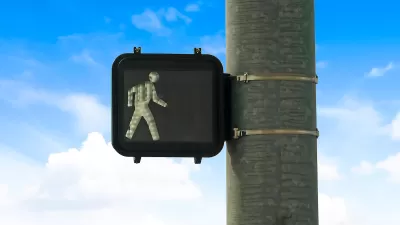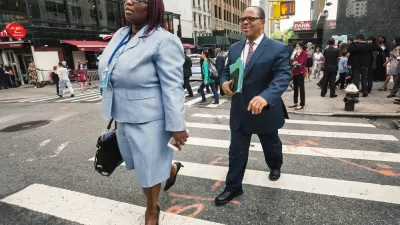In many locales, instruments like traffic studies take pedestrian health into little account. According to Lark Lo, healthy communities haven't been much of a priority at all.

For Next City, Lark Lo makes an impassioned case for greater emphasis on public and pedestrian health. "People are not in their cars when they spend money. People who don’t own cars have money to spend. People are the reason that buildings are built. Developments without people are viewed as not being successful."
The majority of U.S. counties and cities, Lo writes, do not require developers to take into account "how their developments impact people who are using active forms of transportation to get around."
In general, the health of people should come before the ease of traffic flow. "Planning boards must demand developers show how their projects will add to the health and wellness of the communities they build in. The onus of the health of our communities cannot just be on individual people to avoid 2-ton hazards."
FULL STORY: Planning Boards Must Put Healthy Communities at Center of Real Estate Decisions

Planetizen Federal Action Tracker
A weekly monitor of how Trump’s orders and actions are impacting planners and planning in America.

Maui's Vacation Rental Debate Turns Ugly
Verbal attacks, misinformation campaigns and fistfights plague a high-stakes debate to convert thousands of vacation rentals into long-term housing.

Restaurant Patios Were a Pandemic Win — Why Were They so Hard to Keep?
Social distancing requirements and changes in travel patterns prompted cities to pilot new uses for street and sidewalk space. Then it got complicated.

In California Battle of Housing vs. Environment, Housing Just Won
A new state law significantly limits the power of CEQA, an environmental review law that served as a powerful tool for blocking new development.

Boulder Eliminates Parking Minimums Citywide
Officials estimate the cost of building a single underground parking space at up to $100,000.

Orange County, Florida Adopts Largest US “Sprawl Repair” Code
The ‘Orange Code’ seeks to rectify decades of sprawl-inducing, car-oriented development.
Urban Design for Planners 1: Software Tools
This six-course series explores essential urban design concepts using open source software and equips planners with the tools they need to participate fully in the urban design process.
Planning for Universal Design
Learn the tools for implementing Universal Design in planning regulations.
Heyer Gruel & Associates PA
JM Goldson LLC
Custer County Colorado
City of Camden Redevelopment Agency
City of Astoria
Transportation Research & Education Center (TREC) at Portland State University
Jefferson Parish Government
Camden Redevelopment Agency
City of Claremont




























